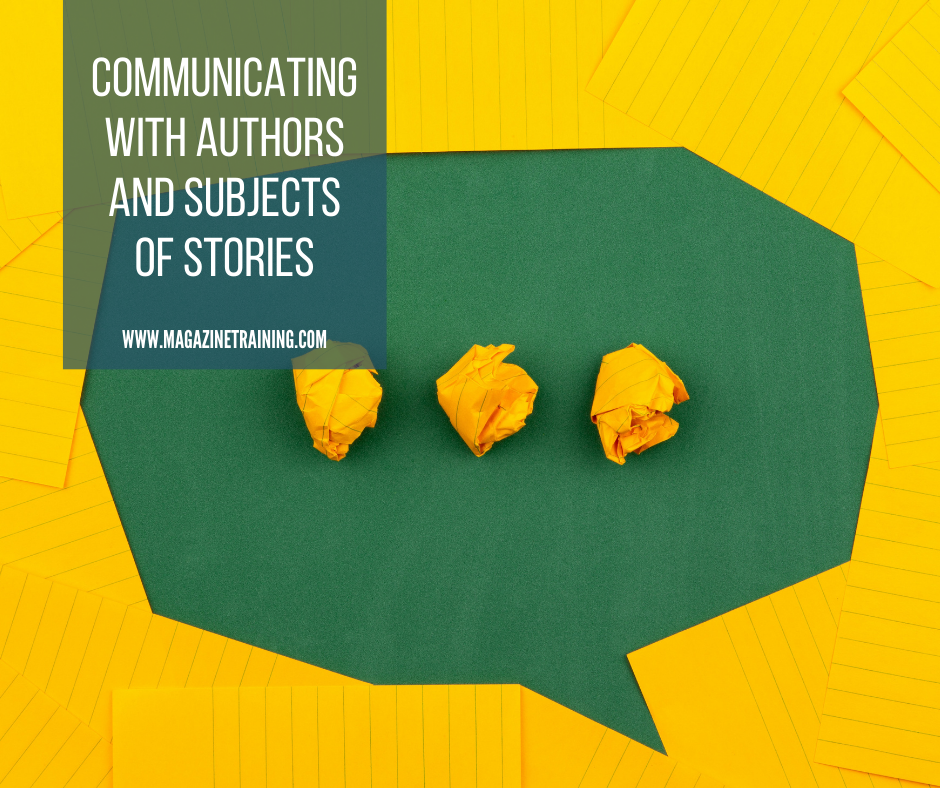
As an editor, I want an article that goes into a magazine or on a website to reach the reader, so the reader is always my first consideration when I am editing. Is the message clear? Is the content compelling? Will the content have an impact on the life of the reader? The relationship with the reader is foremost in the mind of the editor.
However, there are other relationships that matter in publishing as well. As an editor I need to consider the relationship with the author of an article, and also the relationship with people who are mentioned in the article. While the reader is primary, I also need to build relationships with authors and subjects.
There are two points in the publishing process when I communicate with the author of an article and with people mentioned in the article. You can adapt this process for your own needs, but over years of publishing, I have found this process useful and practical.
I send an article to the author and to any people mentioned in the article when I have an edited draft, before it goes to the designer. This is the easiest point to make changes in the article. Once the designer spends time on the layout, it harder to add to the word count or reduce the length of the article.
At this point I am clear as to what I am asking of the author and subjects. I don’t want them to rewrite the whole article or to change all of their quoted content. I want them to verify the accuracy and tone of the article. I also give a clear deadline and mention that there is a specific word count for the article, so if they add content, I will also be streamlining some other aspect of the article.
Here’s a sample of an email to a subject of an article (you will notice I am the author and editor in this case):
Thanks for your time on the phone this week – I enjoyed getting to know a little more about your story and faith journey. I’ve attached a draft of the article. It’s always hard to fit everything in – I tried to focus on the key areas. Please review the article and let me know if you have any changes/corrections. Please let me know of changes by [date]. The article will also go through a review cycle with the communications team.
Usually someone will respond with only minor changes. However, sometimes they want to add quite a bit of additional information. At this point, as the editor, I have to stay focused on the purpose of the article and how the reader will receive the information. Often the additional details they have added don’t really add to the trajectory of the story. However, I may try to incorporate a little of the new material if appropriate, to respect their contribution to the story.
The next time I communicate with the author or subject will be after we have a design draft of the article. I want their approval, but not any significant changes, so I carefully word my request to reflect the nature of the process.
Here’s a sample of an email to a subject with the near-final design draft:
I’ve attached the near-final design draft of the story for [magazine]. Thanks so much for sharing your story – it will encourage others to think about how they grow disciples as well. This will also go through our internal proofing process, so there may be some small changes. I have incorporated changes from previous reviews. Please let me know if there are any errors by [date].
At this point in the process I am not asking for changes to the article. I am looking for any factual errors that I need to correct. If someone does come back with substantial changes at this point, I will evaluate the changes based on the purpose of the article and the reader. Usually I will politely redirect any additional changes, saying:
Thanks for that feedback, for the purposes of this article and the space we have available, we will not be including …
My communication with the author and/or subjects of the article are important for the reputation and goodwill of the magazine. So those relationships matter. However, the reader of the magazine is always the primary focus, so the final article needs to meet the needs of the reader. As the editor, I hold these relationships in a balance and work to have positive interactions with everyone involved in an article.
 By Carla Foote, Fine Print Editorial
By Carla Foote, Fine Print Editorial
Related posts
Magazine Training International’s mission is to encourage, strengthen, and provide training and resources to Christian magazine publishers as they seek to build the church and reach their societies for Christ.

